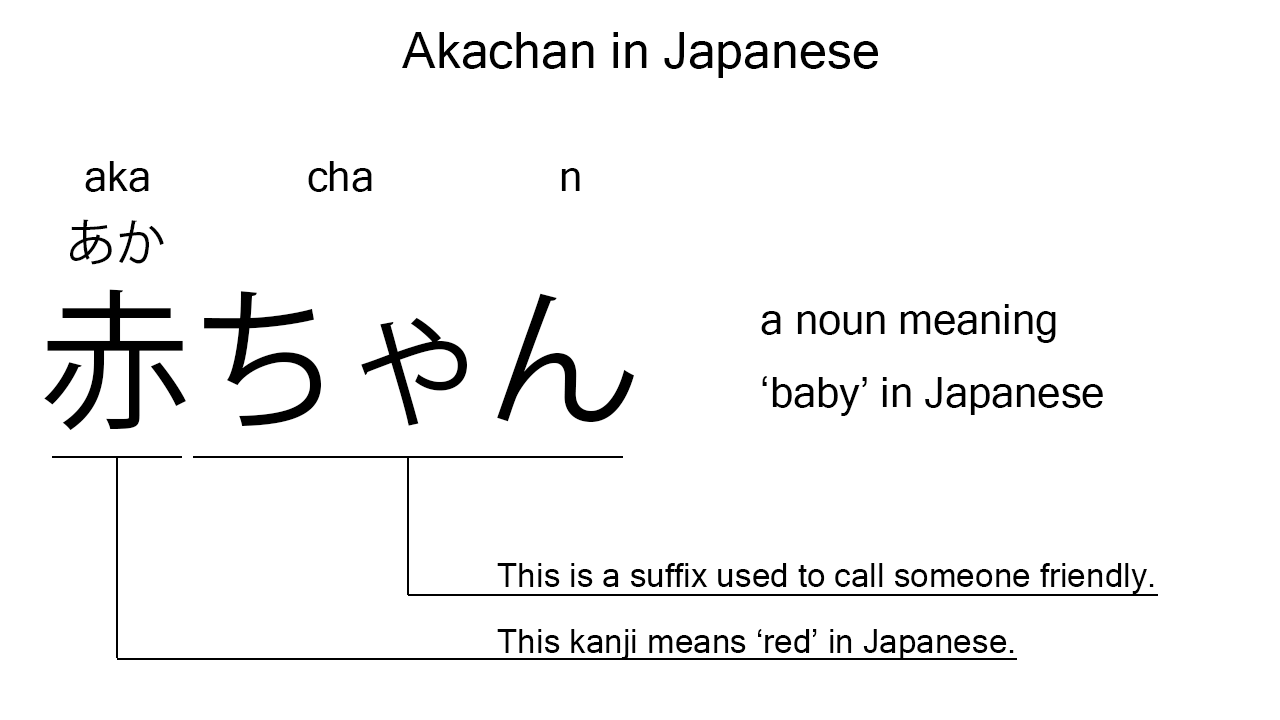What does “akachan” mean in Japanese?
Native speakers say “akachan” to mean ‘baby’ in Japanese. Perhaps, some Japanese learners know this word as it is sometimes used in Japanese movies, novels, manga, anime, and the like. In this blog post, however, I will explain this word in detail based on its grammatical components. And also, I will explain how to use it through example sentences. My explanations would help Japanese learners understand “akachan” more clearly. Then, let’s get started!
Contents
Definition and meaning of “akachan”
Let me start with the definition and meaning of “akachan”.
- akachan – 赤ちゃん (あかちゃん) : a noun meaning ‘baby’ in Japanese. This can also work as plural. Learn more about Japanese plural.
Native speakers use this noun to refer to a baby or babies in Japanese. It’s also worth mentioning here that this noun cannot refer to someone who is in a romantic relationship with someone else. So, its usage is a bit different from those of the English noun, “baby”, I think.
The definition and meaning are very simple and clear. To understand this noun more clearly, however, let me explain its grammatical components in detail, one by one.
What does “akachan” literally mean in Japanese?
“Akachan” consists of the following two components:
- aka – 赤 (あか) : a noum meaning ‘red’ in Japanese.
- chan – ちゃん : a suffix often used after someone’s name to call them friendly. This can be considered as the casual version of the most famous honorific suffix, “san”.
These two components tell us that “akachan” is literally a word to friendly call something red. This literal interpretation is a bit weird, but still understandable, I think. We can easily find a red color on the face of a baby as the skin is still very thin. This seems to be the reason Japanese people started to use the word which means ‘red’ in Japanese to refer to babies.

When we meet new Japanese words, we should check their grammatical components in detail to understand their meanings clearly and deeply. In many cases, components tell us a lot about the meanings of the words they form. Actually, here, we could get the better understanding of “akachan” through the detailed check above.
So far, I’ve explained the definition and meaning of “akachan” together with its grammatical components. Then, let me explain how to use it through the example sentences below.
Example #1: how to say “baby” in Japanese
kanojo no akachan wa totemo kawaii desu – 彼女の赤ちゃんはとても可愛いです (かのじょのあかちゃんはとてもかわいいです)
Her baby is very cute.
Below are the new words used in the example sentence.
- kanojo – 彼女 (かのじょ) : a pronoun meaning ‘she’ in Japanese.
- no – の : a case particle used after a noun or pronoun to make its possessive case. In the example, this is used after “kanojo” to make its possessive case, “kanojo no”, which means ‘her’ in Japanese.
- wa – は : a binding particle working as a case marker or topic marker. In the example, this works after “kanojo no akachan” to make the subject in the sentence.
- totemo – とても : an adverb of degree meaning ‘very’, ‘much’, or such in Japanese. In the example, this works before “kawaii” to emphasize its meaning.
- kawaii – 可愛い (かわいい) : an i-adjective meaning ‘cute’ in Japanese.
- desu – です : an auxiliary verb used after a noun or adjective to make it polite. Probably, this is well known as a part of Japanese desu form. In the example, this is used after “kawaii” to make it sound polite.
This is a typical usage of “akachan”. In this example, it works together with the possessive case, “kanojo no”, to mean ‘her baby’ in Japanese. When we want to say “baby” in Japanese, anyway, this noun is a very good option.
Example #2: another usage of “akachan”
inu no akachan wa kawaii desu ne – 犬の赤ちゃんは可愛いですね (いぬのあかちゃんはかわいいですね)
Puppies are cute, aren’t they?
Below are the new words used in the example sentence.
- inu – 犬 (いぬ) : a noun meaning ‘dog’ in Japanese. This can also work as plural.
- no – の : a case particle joining two nouns. Normally, the first one can work as a modifier to describe the second. In the example, this works to join “inu” and “akachan”. The formed phrase literally means ‘dog babies’ in Japanese, but has been translated as ‘puppies’.
- ne – ね : a sentence-ending particle used to ask for agreement. As the definition suggests, this is used at the end of the example sentence to ask for agreement. This has been reflected as “aren’t they?” in the English sentence.
This is another typical usage of “akachan”. In this example, it works as a part of the noun phrase, “inu no akachan”, which means ‘puppies’ in Japanese. It’s worth knowing that this Japanese noun can also refer to babies of animals.
Summary
In this blog post, I’ve explained the definition and meaning of “akachan” in detail based on its grammatical components. And also, I’ve explained how to use it through the example sentences. Let me summarize them as follows.
- akachan – 赤ちゃん (あかちゃん) : a noun meaning ‘baby’ in Japanese. This can also work as plural. This is literally a word to friendly call something red. This literal interpretation is a bit weird, but still understandable, I think. We can easily find a red color on the face of a baby as the skin is still very thin. This seems to be the reason Japanese people started to use the word which means ‘red’ in Japanese to refer to babies.
Hope my explanations are understandable and helpful for Japanese learners.
Leave a Reply